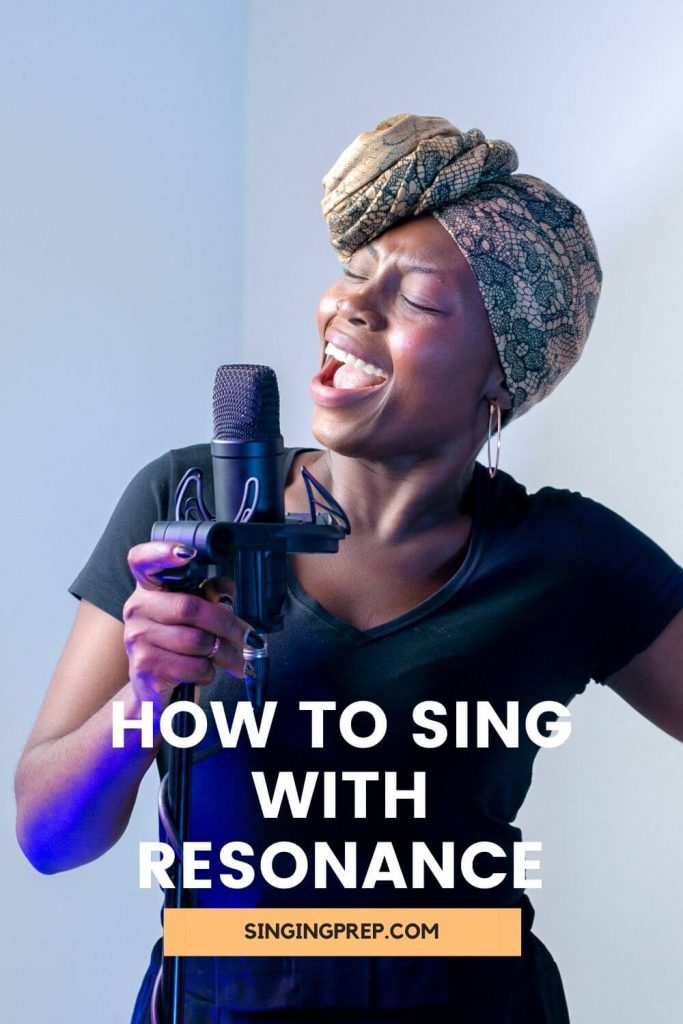Ever wondered how to sing with resonance and do it the best you can? Are you trying to sing with the resonance and build some good sort of resonance in your voice?
If you have these questions in your voice, then you are in the right place because I am going to show you one of the best ways through which you will be able to build the characteristics of resonance in your voice and you will be able to rock the stage.
The whole practice of singing with the resonance lies in the success of how you are going to pronounce the vowels and use them in your singing.
If it sounds easy to you, then I must tell you that it is not that easy as you are thinking because it needs proper training and people spend their ages doing that. So, let us get to the work!

What is resonance?
If you are searching on how to sing with resonance, you probably know what it is, but for amateurs, let me first explain what resonance is.
In basic terms, resonance means the quality in a sound of being deep and full, hence resonance in singing must be that your voice is loud and capable of prolongation.
Building resonance means enhancing the intensity of the voice and there are quite a several ways to ensure this. Some synonyms that might be used for resonance can be amplification, intensification, enlargement, filtering, etc. which might confuse you, but they are the same thing as resonance.
Let us understand better:
To better understand a resonant voice, the letter Z’s sound is the best example, when you make a ZZZZZ sound, it entails resonance in your voice as opposed to the SSSSS sound which denotes sibilance which is made by directing the stream of air with your tongue towards the teeth, whereas the resonant sound occurs in the vocal tract.
Similar to Z, M, V, and N also produce a resonant sound. Just you have to keep in your mind that you have to make the sound like a snake’s hiss and changing that into a be buzz. You have to make sure that you are making a difference between the articulation between the S sound and Z sound.
Also, make sure that you are doing the same between the actual resonance and vocal tract as well. It is very important if you want to identify your true voice and also in what category of voice resonance you are falling. First of all, you need to learn that how you can place your voice.
Instead of wasting thousands of dollars learning how to build a resonant voice, you can easily follow the steps below and master it at home.
The correct voice placement:
Once you get to know about the correct position and placement of your voice, singing with the correct resonance will be very easy for you. This learning and placement can be very tricky because there are many differences in the speaking and singing accents in people, also there are numerous voice types.
If you are having a speaking voice, then it would be very difficult for you to have resonance in your voice and you will not be able to differentiate between your true resonance as well.
The easiest way to do the right vocal placement is with the help of breaking the voice into 3 main elements of the singing, that are:
- Pressure.
- Vibration.
- Resonance.
If you are breaking the voice into these elements, you will be able to work on your fundamental support, fold closure, and vowels as well.
So, you have to create some direct frequencies and then direct your frequencies towards certain parts of your vocal tract and make that appear that your voice is resonating in a different spot because the vocal placement is not about moving your voice, but it is all about the practice.
Practice using alphabetical sounds:
The first step would be to practice as much as you can. To begin with, the basic practice would be to make sounds of the alphabets mentioned above, like Z, M, N, V to mention a few.
This will help you in building a depth and hold in your voice because your vocal cords will get used to making these sounds that entail loudness and depth and enable you to make prolonged voices.
Exercises to develop resonance in your voice:
As you came to know about the Z resonant voice, so you can now practice with any voice and scale that you want, then you can do the training and exercise while using that. You can also use many other sounds like N, M, and NG to create resonance.
The main concept of resonance is to develop some buzz and resonance in your voice, especially in your vowels. You have to learn how to sing vowels because it is the main part of this practice.
The best vowel for this practice is the EE vowel because it naturally leads you towards the bright and buzzing voice. You have to switch to the different vowel sounds like EE AY AH OH, and it will help you to get to know that which vowels do not have resonance when you are singing it.
Focus on the four vital vocal fundamentals:
To gain vibrato (an effect in which a pulsating change of pitch prevails) it is essential to follow these four vocal fundamentals and work on them to make sure that you get a resonant voice. Vibrato and Resonance are internally related and co-dependent. These four vocal fundamentals are as follows:
- Height in the vocal tract
- Forward placement
- Mixed Tonality
- All in one flow
Almost all the vocal techniques out there relate to these four vocal fundamentals, hence making them fundamental. For instance, yawning, vocal modification, lifting the soft palate, etc are all techniques relating to the height in the vocal tract, the first of the vocal fundamentals.
These vocal techniques are just a tail of heightening your vocal tract. Therefore, if you focus on just these four fundamentals, you can not only gain resonance but you will be able to master any other vocal technique to existing.
Looking deep into the 4 fundamentals:
Height in the vocal tract:
Have you ever heard of yawning when you are singing? Some singers use this technique to create a height in their vocal tract by yawning more when they are singing.
One of the best ways to create height in your singing is with the help of an “Internal smile”. This internal smile is not just a smile, but it consists of the main following steps that will help you to get resonance when you are singing:
- Bright eyes.
- Cheeks raised under the eyes.
- Sunken cheeks at the back of your mouth.
- The narrow opening of your mouth.
Raised soft palate.
You can also use this with the help of the K sound inhaling with the help of your tongue that should be touching the roof of your mouth. You have to take a deep breath in so a little pressure can be made. In this way, your soft palate will raise and the cold air will rush into your larynx.
Forward placement:
The second important fundamental element is the forward placement that helps in creating resonance in your voice. If you are singing with the resonance, then you are more likely to have a powerful and pleasant voice that will be creating a “Buzz” like most of your favorite singers.
Forward placement creates this very easy for you. If you are afraid of getting a bright tone after the forward placement, then you don’t need to worry because it is one of the key elements of a balanced voice.
You can train forward placement with the help of some exercises like NYAH or NAY. It should be a smooth and natural practice rather than forced.
Mixed Tonality:
Once you get to know how you can sing with your mixed voice that is consisted of your head voice and chest voice, you will be able to sing in your low as well and high pitch. It has two main parts:
Physical: You have to get a balance between your TA and CT muscles.
Resonant: You have to make a blended resonance between your chest and head registers.
This training will help you to sing in any range, despite the voice type you have.
All in One flow:
Have you ever noticed the difference between “Hahahaha” and “Haaaaaaa” which are two types of laughs? This is because of the different accents and different voice types. If you wanna improve your voice, click here. This is what we say the all-in-one flow that has consistent airflow.
This training is different for each singer like some singers hold the air back by resisting the recoil of their diaphragm just make sure that they don’t sound too breathy when they are singing.
It is the simplest fundamental approach and this can be done just by making proper adjustments to your diaphragm, and a balance between the airflow and air pressure.
Conclusion: How To Sing With Resonance
You have read all the main and important points and now you have to work on them. Just make sure that you are giving a proper time to the change and you are not harming your voice in any case.
If you wanna improve your singing and to get professional advice from a professional singer, click here.
Check out some of the most incredible testimonials from people that tried Singorama and improved their singing:

You get a 60-day money-back guarantee on 100% of the money you pay, and you get a 75% discount which makes this deal a one time offer, so don’t wait and get a discount by clicking here.